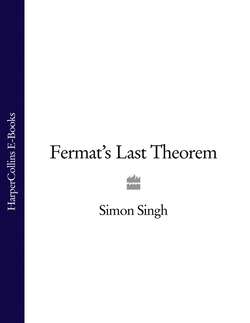Читать книгу Fermat’s Last Theorem - Simon Singh, Simon Singh - Страница 13
An Infinity of Triples
ОглавлениеThe Pythagorean Brotherhood invigorated mathematics with its zealous search for truth via proof. News of their success spread and yet the details of their discoveries remained a closely guarded secret. Many requested admission to the inner sanctum of knowledge, but only the most brilliant minds were accepted. One of those who was blackballed was a candidate by the name of Cylon. Cylon took exception to his humiliating rejection and twenty years later he took his revenge.
During the sixty-seventh Olympiad (510 BC) there was a revolt in the nearby city of Sybaris. Telys, the victorious leader of the revolt, began a barbaric campaign of persecution against the supporters of the former government, which drove many of them to seek sanctuary in Croton. Telys demanded that the traitors be returned to Sybaris to suffer their due punishment, but Milo and Pythagoras persuaded the citizens of Croton to stand up to the tyrant and protect the refugees. Telys was furious and immediately gathered an army of 300,000 men and marched on Croton, where Milo defended the city with 100,000 armed citizens. After seventy days of war Milo’s supreme generalship led him to victory and as an act of retribution he turned the course of the river Crathis upon Sybaris to flood and destroy the city.
Despite the end of the war, the city of Croton was still in turmoil because of arguments over what should be done with the spoils of war. Fearful that the lands would be given to the Pythagorean elite, the ordinary folk of Croton began to grumble. There had already been growing resentment among the masses because the secretive Brotherhood continued to withhold their discoveries, but nothing came of it until Cylon emerged as the voice of the people. Cylon preyed on the fear, paranoia and envy of the mob and led them on a mission to destroy the most brilliant school of mathematics the world had ever seen. Milo’s house and the adjoining school were surrounded, all the doors were locked and barred to prevent escape and then the burning began. Milo fought his way out of the inferno and fled, but Pythagoras, along with many of his disciples, was killed.
Mathematics had lost its first great hero, but the Pythagorean spirit lived on. The numbers and their truths were immortal. Pythagoras had demonstrated that more than any other discipline mathematics is a subject which is not subjective. His disciples did not need their master to decide on the validity of a particular theory. A theory’s truth was independent of opinion. Instead the construction of mathematical logic had become the arbiter of truth. This was the Pythagoreans’ greatest contribution to civilisation – a way of achieving truth which is beyond the fallibility of human judgement.
Following the death of their founder and the attack by Cylon, the Brotherhood left Croton for other cities in Magna Graecia, but the persecution continued and eventually many of them had to settle in foreign lands. This enforced migration encouraged the Pythagoreans to spread their mathematical gospel throughout the ancient world. Pythagoras’ disciples set up new schools and taught their students the method of logical proof. In addition to their proof of Pythagoras’ theorem, they also explained to the world the secret of finding so-called Pythagorean triples.
Figure 3. Finding whole number solutions to Pythagoras’ equation can be thought of in terms of finding two squares which can be added together to form a third square. For example, a square made of 9 tiles can be added to a square of 16 tiles, and rearranged to form a third square made of 25 tiles.
Pythagorean triples are combinations of three whole numbers which perfectly fit Pythagoras’ equation: x2 + y2 = z2 For example, Pythagoras’ equation holds true if x = 3, y = 4 and z = 5:
Another way to think of Pythagorean triples is in terms of rearranging squares. If one has a 3 × 3 square made of 9 tiles, and a 4 × 4 square made of 16 tiles, then all the tiles can be rearranged to form a 5 × 5 square made of 25 tiles, as shown in Figure 3.
The Pythagoreans wanted to find other Pythagorean triples, other squares which could be added to form a third, larger square. Another Pythagorean triple is x = 5, y = 12 and z = 13:
A larger Pythagorean triple is x = 99, y = 4,900 and z = 4,901. Pythagorean triples become rarer as the numbers increase, and finding them becomes harder and harder. To discover as many triples as possible the Pythgoreans invented a methodical way of finding them, and in so doing they also demonstrated that there are an infinite number of Pythagorean triples.
